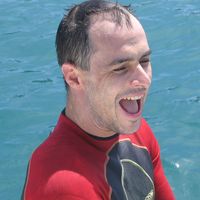
Laurent Duval
Research amateur - signal, image and anagram processing, data science
less
Related Authors
Steven J. Miller
Williams College
Jordi Vallverdú
Universitat Autònoma de Barcelona
George Kaviris
National & Kapodistrian University of Athens
Ashok K Karmokar
University of British Columbia
Janusz Konrad
Boston University
Asha Vijayan
Amrita Vishwa Vidyapeetham
Marc Champagne
Kwantlen Polytechnic University
Vijaykumar Chakka
Shiv Nadar University
David Seamon
Kansas State University
VISWANATHAN P
VIT University
InterestsView All (32)









Uploads
Papers by Laurent Duval
Nous présentons BEADS, une méthode d'optimisation permettant d'extraire conjointement la mesure d'intérêt, débruitée et corrigée de la ligne de base. En l'absence de modèles paramétriques naturels pour cette dernière, nous adoptons une modélisation globale légère, s'appuyant sur l'aspect "positif" des pics, et sur la parcimonie de leurs dérivées.
Le problème de filtrage de la ligne de base et de débruitage est alors reformulé comme la minimisation d'une fonction comportant un terme de fidélité aux données et de pénalités promotrices de positivité et de parcimonie. Les performances seront illustrées notamment sur des chromatogrammes 1D et 2D, en évoquant d'autres usages récents (spectrométie de masse, Raman, XAS/XRD). Des perspectives en déconvolution seront enfin abordées.
Chaque filtre unaire compense des écarts d'amplitude et des décalages faibles et plus importants, via des corrections de phase et de délai entier, dans une bande de fréquence très étroite. Cette approche simplifie grandement l'estimation du filtre adapté, et fournit, même en 1D, des résultats comparables à des approches 2D classiques, à un coût de calcul très compétitif.
Adaptive multiple subtraction with wavelet-based complex unary Wiener filters, S. Ventosa, S. Le Roy, Irène Huard, A. Pica, H. Rabeson, P. Ricarte, L. Duval, Geophysics, number 77, vol. 183, p. 183-192, Nov.-Dec. 2012
http://arxiv.org/abs/1108.4674
Additional information:
http://www.sciencedirect.com/science/article/pii/S0165168411001356
The richness of natural images makes the quest for optimal La quête de représentations optimales en traitement d'images et vision par ordinateur se heurte à la variété de contenu des données bidimensionnelles. De nombreux travaux se sont cependant attelées à la tâche de séparation de zones régulières, de contours et de textures, à la recherche d'un compromis entre complexité et efficacité de représentation. La prise en compte des aspects multi-échelles, dans le siècle de l'invention des ondelettes, a joué pour l'analyse d'images un rôle important. La dernière décennie a vue apparaître une série de méthodes efficaces, combinant l'aspect multi-échelle à des aspects directionnels et fréquentiels, permettant de mieux prendre en compte l'orientation des éléments d'intérêt des images. Leur fréquente redondance leur permet d'obtenir des représentations plus parcimonieuses et parfois quasi-équivariantes pour certaines transformations. Ces méthodes sont la motivation d'une revue thématique incluant quelques incursions dans des domaines non-euclidiens (sphère, maillages).representations in image processing and computer vision challenging. The latter observation has not prevented the design of image representations, which trade off between efficiency and complexity, while achieving accurate rendering of smooth regions as well as reproducing faithful contours and textures. The most recent ones, proposed in the past decade, share an hybrid heritage highlighting the multiscale and oriented nature of edges and patterns in images. This paper presents a panorama of the aforementioned literature on decompositions in multiscale, multi-orientation bases or dictionaries. They typically exhibit redundancy to improve sparsity in the transformed domain and sometimes its invariance with respect to simple geometric deformations (translation, rotation). Oriented multiscale dictionaries extend traditional wavelet processing and may offer rotation invariance. Highly redundant dictionaries require specific algorithms to simplify the search for an efficient (sparse) representation. We also discuss the extension of multiscale geometric decompositions to non-Euclidean domains such as the sphere or arbitrary meshed surfaces. The etymology of panorama suggests an overview, based on a choice of partially overlapping "pictures". We hope that this paper will contribute to the appreciation and apprehension of a stream of current research directions in image understanding.
The richness of natural images makes the quest for optimal La quête de représentations optimales en traitement d'images et vision par ordinateur se heurte à la variété de contenu des données bidimensionnelles. De nombreux travaux se sont cependant attelées à la tâche de séparation de zones régulières, de contours et de textures, à la recherche d'un compromis entre complexité et efficacité de représentation. La prise en compte des aspects multi-échelles, dans le siècle de l'invention des ondelettes, a joué pour l'analyse d'images un rôle important. La dernière décennie a vue apparaître une série de méthodes efficaces, combinant l'aspect multi-échelle à des aspects directionnels et fréquentiels, permettant de mieux prendre en compte l'orientation des éléments d'intérêt des images. Leur fréquente redondance leur permet d'obtenir des représentations plus parcimonieuses et parfois quasi-équivariantes pour certaines transformations. Ces méthodes sont la motivation d'une revue thématique incluant quelques incursions dans des domaines non-euclidiens (sphère, maillages).representations in image processing and computer vision challenging. The latter observation has not prevented the design of image representations, which trade off between efficiency and complexity, while achieving accurate rendering of smooth regions as well as reproducing faithful contours and textures. The most recent ones, proposed in the past decade, share an hybrid heritage highlighting the multiscale and oriented nature of edges and patterns in images. This paper presents a panorama of the aforementioned literature on decompositions in multiscale, multi-orientation bases or dictionaries. They typically exhibit redundancy to improve sparsity in the transformed domain and sometimes its invariance with respect to simple geometric deformations (translation, rotation). Oriented multiscale dictionaries extend traditional wavelet processing and may offer rotation invariance. Highly redundant dictionaries require specific algorithms to simplify the search for an efficient (sparse) representation. We also discuss the extension of multiscale geometric decompositions to non-Euclidean domains such as the sphere or arbitrary meshed surfaces. The etymology of panorama suggests an overview, based on a choice of partially overlapping "pictures". We hope that this paper will contribute to the appreciation and apprehension of a stream of current research directions in image understanding. "
The discovery of novel gene regulatory processes improves the understanding of cell phenotypic responses to external stimuli for many biological applications, such as medicine, environment or biotechnologies. To this purpose, transcriptomic data are generated and analyzed from DNA microarrays or more recently RNAseq experiments. They consist in genetic expression level sequences obtained for all genes of a studied organism placed in different living conditions. From these data, gene regulation mechanisms can be recovered by revealing topological links encoded in graphs. In regulatory graphs, nodes correspond to genes. A link between two nodes is identified if a regulation relationship exists between the two corresponding genes. Such networks are called Gene Regulatory Networks (GRNs). Their construction as well as their analysis remain challenging despite the large number of available inference methods.
In this thesis, we propose to address this network inference problem with recently developed techniques pertaining to graph optimization. Given all the pairwise gene regulation information available, we propose to determine the presence of edges in the final GRN by adopting an energy optimization formulation integrating additional constraints. Either biological (information about gene interactions) or structural (information about node connectivity) a priori have been considered to restrict the space of possible solutions. Different priors lead to different properties of the global cost function, for which various optimization strategies, either discrete and continuous, can be applied. The post-processing network refinements we designed led to computational approaches named BRANE for \Biologically-Related A priori for Network Enhancement". For each of the proposed methods --- BRANE Cut, BRANE Relax and BRANE Clust --- our contributions are threefold: a priori-based formulation, design of the optimization strategy and validation (numerical and/or biological) on benchmark datasets from DREAM4 and DREAM5 challenges showing numerical improvement reaching 20%.
In a ramification of this thesis, we slide from graph inference to more generic data processing such as inverse problems. We notably invest in HOGMep, a Bayesian-based approach using a Variational Bayesian Approximation framework for its resolution. This approach allows to jointly perform reconstruction and clustering/segmentation tasks on multi-component data (for instance signals or images). Its performance in a color image deconvolution context demonstrates both quality of reconstruction and segmentation. A preliminary study in a medical data classification context linking genotype and phenotype yields promising results for forthcoming bioinformatics adaptations.